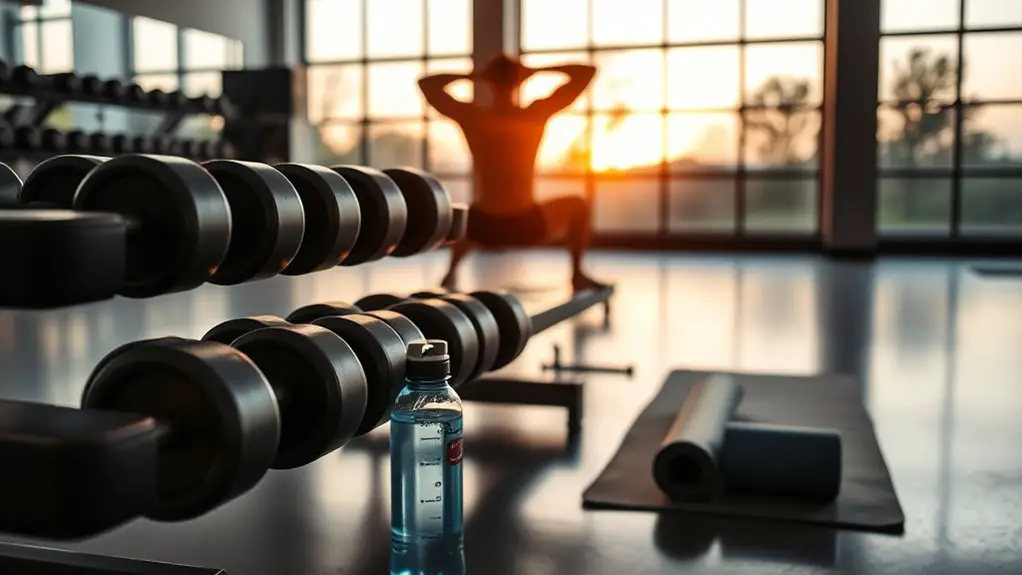How to Build Muscle Effectively in the Gym

To build muscle effectively in the gym, you need to understand how muscle growth works. Focus on compound exercises like squats and deadlifts for overall strength, while including isolation moves for specific muscles. Always prioritize proper form to avoid injuries and enhance muscle engagement. Don’t forget the importance of nutrition—aim for a balanced diet and protein intake post-workout. Finally, make certain you get adequate rest and recovery. Discovering more tips could take your training to the next level.
Understanding Muscle Growth: The Science Behind It

When you plunge into muscle growth, it’s crucial to understand the science behind it. Muscle hypertrophy mechanisms are the processes that help your muscles increase in size. Basically, when you lift weights, you create tiny tears in your muscle fibers. Your body then repairs these tears, making the fibers stronger and larger in the process.
A key player in this journey is the protein synthesis process. After your workout, your body kicks into gear, using protein to repair and build new muscle tissue. To support this, you’ll want to make certain you’re consuming enough protein through your diet. It’s essential to focus on both quality and quantity to promote effective recovery and growth.
Understanding these mechanisms not only helps you achieve your goals but also guarantees you’re doing it safely. So, educate yourself, listen to your body, and give it the nutrients it needs to thrive.
Selecting the Right Exercises for Maximum Impact
How do you know which exercises will truly maximize your muscle growth? To build muscle effectively, focus on incorporating both compound movements and isolation exercises into your routine. Compound movements, like squats and deadlifts, engage multiple muscle groups at once, allowing you to lift heavier weights safely and efficiently. These exercises are essential for overall strength and muscle mass.
On the other hand, isolation exercises, such as bicep curls and tricep extensions, target specific muscles. They can help address muscle imbalances and refine your physique. When selecting exercises, consider your fitness level and any existing injuries. Always prioritize your safety by starting with lighter weights and gradually increasing intensity as you gain confidence. Additionally, incorporating activities like skipping can enhance cardiovascular fitness and improve overall workout performance.
Ultimately, a balanced approach that combines these two types of exercises will help you maximize your muscle growth while minimizing the risk of injury. Keep your goals in mind, and adjust your routine as needed!
Mastering Proper Form and Technique

Mastering proper form and technique is essential for building muscle effectively and preventing injuries in the gym. When you focus on body alignment, you guarantee that your muscles work at their best while reducing strain on your joints. Start by learning the fundamentals of each exercise, paying close attention to your posture and movement patterns.
Utilize exercise variations to challenge your muscles differently while still maintaining proper form. For example, if you’re doing squats, try variations like front squats or sumo squats to engage your muscles in new ways, but always prioritize technique over weight.
Take the time to practice in front of a mirror or ask a trainer for feedback. Remember, it’s better to lift lighter weights with proper form than to risk injury by lifting heavier but incorrectly. By mastering form and technique, you’ll set a strong foundation for your muscle-building journey.
Nutrition Essentials for Muscle Building
Building muscle isn’t just about lifting weights; nutrition plays an essential role in your progress. To maximize your gains, focus on the right macronutrient ratios. Aim for a balanced intake of proteins, carbohydrates, and fats. A common guideline is 40% carbs, 30% protein, and 30% fats, but you may need to adjust this based on your body type and fitness goals.
Meal timing also matters. Eating a protein-rich meal about 30 minutes after your workout can help your muscles recover and grow. Don’t skip meals throughout the day; consistent nourishment is key.
Incorporating whole foods like lean meats, whole grains, and healthy fats will support your muscle-building efforts while ensuring you stay safe and healthy. Remember, it’s not just about what you eat, but when you eat it, that can make all the difference in your muscle growth journey.
Recovery: The Key to Sustained Progress

While many focus on intense workouts to build muscle, recovery is just as essential for achieving sustained progress. You need to prioritize rest days and guarantee you’re getting quality sleep for peak muscle repair and growth. Without adequate recovery, your body can’t rebuild stronger, leading to fatigue and potential injury.
Here’s a quick look at important recovery aspects:
| Recovery Aspect | Importance |
|---|---|
| Rest Days | Prevent overtraining and fatigue |
| Sleep Quality | Enhances muscle repair and growth |
| Hydration | Supports overall recovery process |
Aim for at least one to two rest days each week, and focus on improving your sleep quality. Create a relaxing bedtime routine and avoid screens before sleeping. By respecting your recovery needs, you’ll guarantee you’re making safe, effective progress in your muscle-building journey. Additionally, recognizing the importance of rest days can help prevent burnout and maintain your motivation in the long run.
Frequently Asked Questions
How Often Should I Change My Workout Routine?
You should consider changing your workout routine every 4 to 6 weeks. This helps prevent plateaus and keeps your muscles challenged. Incorporating principles like progressive overload guarantees you’re consistently pushing your limits. Additionally, using workout periodization can help structure your training for ideal results while minimizing injury risk. Always listen to your body, and if you feel fatigued or strained, it might be time to adjust your routine sooner.
Are Supplements Necessary for Muscle Growth?
Supplements aren’t strictly necessary for muscle growth, but they can be helpful. Timing your protein intake can optimize recovery and muscle repair, especially post-workout. Creatine benefits include increased strength and performance, making your workouts more effective. However, it’s essential to prioritize whole foods and a balanced diet first. Always consult a healthcare professional before starting any supplements to guarantee they’re safe and suitable for your individual needs.
Can Cardio Hinder My Muscle-Building Efforts?
Oh sure, let’s just run a marathon every day and expect those biceps to magically appear! Cardio types like high-intensity interval training (HIIT) can be great, but if you overdo it, you might just end up trading muscle for stamina. Aim for an ideal duration of 20-30 minutes a few times a week. Balance is key; you want to keep that heart healthy without sacrificing your hard-earned gains. Safety first!
What Role Does Sleep Play in Muscle Development?
Sleep plays an essential role in muscle development. When you prioritize sleep duration, your body gets the chance to recover properly, which is important for growth. During deep sleep, your body repairs tissues and releases hormones that aid in muscle recovery. If you’re skimping on sleep, you might hinder your progress. Ensuring you get enough rest each night will help you maximize your muscle-building efforts safely and effectively.
How Do I Stay Motivated in My Fitness Journey?
Staying motivated in your fitness journey can feel like a rollercoaster ride, where ups and downs are inevitable. To keep that motivation alive, start with goal setting—set realistic and achievable targets. Then, track your progress regularly, celebrating small victories along the way. This not only reinforces your commitment but also reminds you of how far you’ve come. Remember, it’s all about consistency and patience; safety should always be your priority as you push forward.





